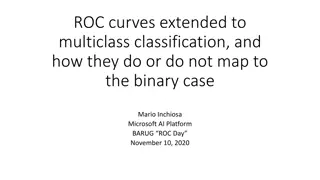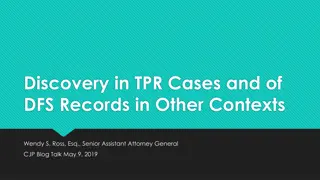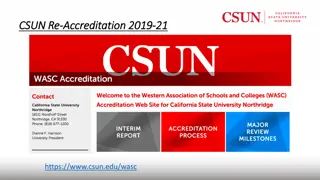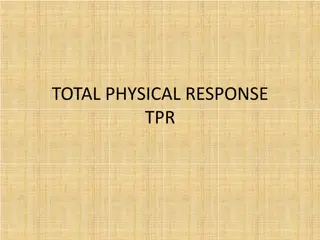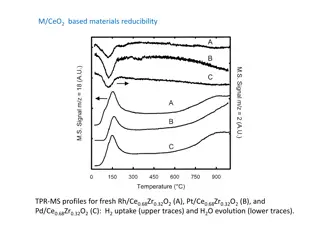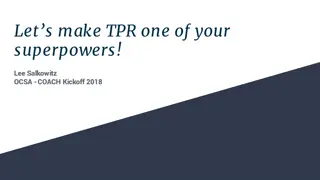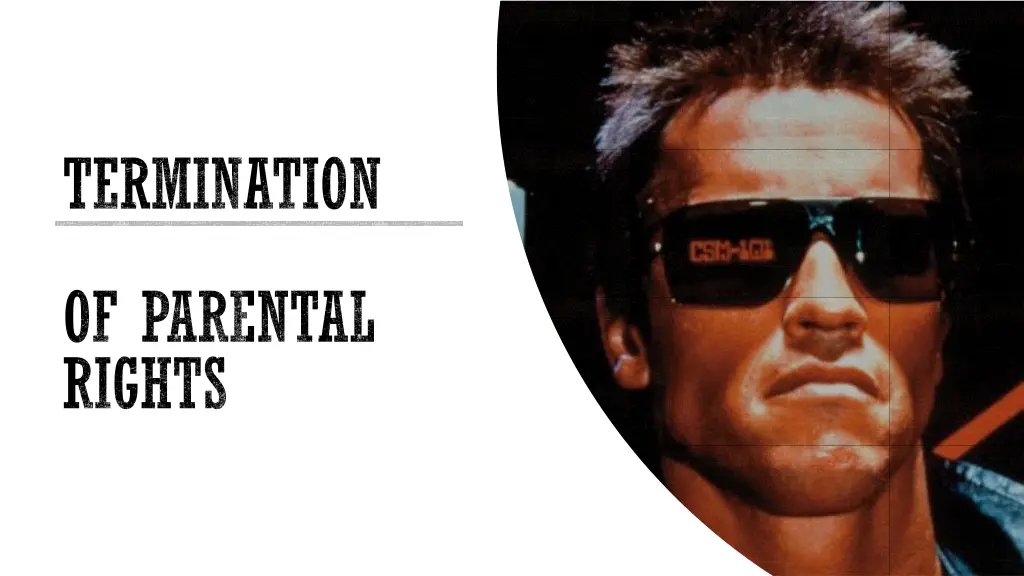
Understanding Termination of Parental Rights Process
Explore the legal process of terminating parental rights, including the two-part test, grounds for termination, and the importance of evidence presentation in court proceedings. Learn about the requirements and implications involved in the decision-making process.
Uploaded on | 0 Views
Download Presentation

Please find below an Image/Link to download the presentation.
The content on the website is provided AS IS for your information and personal use only. It may not be sold, licensed, or shared on other websites without obtaining consent from the author. If you encounter any issues during the download, it is possible that the publisher has removed the file from their server.
You are allowed to download the files provided on this website for personal or commercial use, subject to the condition that they are used lawfully. All files are the property of their respective owners.
The content on the website is provided AS IS for your information and personal use only. It may not be sold, licensed, or shared on other websites without obtaining consent from the author.
E N D
Presentation Transcript
TERMINATION OF PARENTAL RIGHTS
YOU CANT GET TO THIS
WITHOUT THIS
THE BROKEN RECORD - ORDERS Clear as to what evidence was presented, whether by witness, documents, stipulation, etc. Clear as to which facts the court finds (not the whole record). Clear as to how those particular findings of fact lead to the conclusions of law. Consider grouping each finding of fact with a conclusion of law.
TWO PART TEST Determination, by clear and convincing evidence, that one or more of the statutory grounds for termination exist. Determination, by clear and convincing evidence, that termination of parental rights is in the child s best interest.
GROUNDS FOR TERMINATION (1) The parent has given written consent to termination which has been acknowledged by the court or has voluntarily surrendered his or her child for adoption; (2) The parent has subjected his or her child to aggravated circumstances; (3) The parent has wantonly and willfully failed to comply for a period of 12 months or longer with a decree to support his or her child that has been entered by a court of competent jurisdiction of this or any other state; (4) A child is abandoned by his or her parent; or
GROUNDS FOR TERMINATION (5) A child is a dependent child due to lack of proper parental care or control by his or her parent, reasonable efforts to remedy the circumstances have been unsuccessful or were not required, such cause of dependency is likely to continue or will not likely be remedied in the reasonably foreseeable future, and: (A) Returning such child to his or her parent is likely to cause serious physical, mental, moral, or emotional harm to such child or threaten the physical safety or well-being of such child; or (B) Continuation of the parent and child relationship will cause or is likely to cause serious physical, mental, moral, or emotional harm to such child.
GROUNDS FOR TERMINATION In determining whether a child who is not in the custody and care of his or her parent is without proper parental care and control, the court shall also consider, without being limited to, whether such parent, without justifiable cause, has failed significantly for a period of six months prior to the date of the termination hearing: (1) To develop and maintain a parental bond with his or her child in a meaningful, supportive manner; (2) To provide for the care and support of his or her child as required by law or judicial decree; and (3) To comply with a court ordered plan designed to reunite such parent with his or her child.
BEST INTEREST CONSIDERATIONS If any of the statutory grounds for termination has been met, the court shall then consider whether termination is in a child's best interests after considering the following factors: (1) Such child's sense of attachments, including his or her sense of security and familiarity, and the continuity of affection for such child; (2) Such child's wishes and long-term goals; (3) Such child's need for permanence, including his or her need for stability and continuity of relationships with a parent, siblings, and other relatives; (4) Any benefit to such child of being integrated into a stable and permanent home and the likely effect of delaying such integration into such stable and permanent home environment;
BEST INTEREST CONSIDERATIONS (5) The detrimental impact of the lack of a stable and permanent home environment on such child's safety, well-being, or physical, mental, or emotional health; (6) Such child's future physical, mental, moral, or emotional well- being; and (7) Any other factors, including the factors set forth in Code Section 15-11-26, considered by the court to be relevant and proper to its determination.
SERVICE (a) If a party to be served with a summons is within this state and can be found, the summons shall be served upon him or her personally as soon as possible and at least 30 days before the termination of parental rights hearing. (b) If a party to be served is within this state and cannot be found but his or her address is known or can be ascertained with due diligence, the summons shall be served upon such party at least 30 days before the termination of parental rights hearing by mailing him or her a copy by registered or certified mail or statutory overnight delivery, return receipt requested. (c) If a party to be served is outside this state but his or her address is known or can be ascertained with due diligence, service of the summons shall be made at least 30 days before the termination of parental rights hearing either by delivering a copy to such party personally or by mailing a copy to him or her by registered or certified mail or statutory overnight delivery, return receipt requested.
SERVICE (d) If, after due diligence, a party to be served with a summons cannot be found and such party's address cannot be ascertained, whether he or she is within or outside this state, the court may order service of the summons upon him or her by publication. The termination of parental rights hearing shall not be earlier than 31 days after the date of the last publication.
SERVICE IS A MATTER OF PROOF [T]he record contained no evidence that the petitioner filed any motion requesting service by publication, that the petitioner filed an affidavit or presented sworn testimony in support of service by publication, that the trial court concluded that the petitioner exercised due diligence in attempting to personally serve the mother, or that the trial court issued an order permitting service by publication. TPR Reversed. ITIO R.C., 343 Ga. App. 682, 684 (2017)
SERVICE The summons, with petition attached, must be served upon: Mother Legal father Child, if 14+ (may not waive) Guardian/legal custodian Child s attorney Child s GAL
SERVICE Biological father who is not the legal father must be served if: Paternity legally established; Identity is known to petitioner or petitioner s attorney; Putative father registry indicated paternity or possible paternity; or Court receives evidence that the biological father has Lived with the child; Supported the child; Attempted to legitimate the child; or Provided support/medical care for mother during pregnancy or during hospitalization for birth.
PRETRIAL CONSIDERATIONS Consider pre-trial hearings to focus the issues, make more efficient use of trial time, ensure availability of witnesses and status of subpoenas. These can substantially reduce the need for continuances. Consider mediation, using county ADR funds. Unless there is just cause for delay, TPR hearings must be completed within 90 days of filing petition. (O.C.G.A. 15-11-301)
The State bears the burden of proving every element of the petition by clear and convincing evidence, and the burden never shifts to the parents. BURDEN OF PROOF
A mere recitation that [any] legal requirement has been met will not suffice. ITIO A.S., 339 Ga.App. 875, 881 (2016) CLEAR & CONVINCING EVIDENCE
Beyond Reas. Doubt SUBSTANTIALLY MORE LIKELY THAN NOT Clear & Convincing Preponderance Prob. Cause 0 10 20 30 40 50 60 70 80 90 100
EVIDENCE The Juvenile Code clearly contemplates that witnesses must be sworn and subject to cross- examination, hearsay will not be allowed (unless under a statutory exception), parties have the right to confront witnesses, and rules of evidence regarding the introduction of exhibits should be followed. Like the right to counsel, these rights are not optional. ITIO C.H., 343 Ga. App. 1, 13
HOW DOES A COURT LEARN FACTS? 1. Sworn testimony of a witness subject to cross- examination (any facts the court hears) 2. Properly introduced document or exhibit (any words, pictures, or objects the court sees) 3. Stipulation of the parties (any of the above) 4. Judicial notice (properly used)
CONDUCTING THE HEARING Ensure presence of all parties. Proof of service of petition. Parties should ensure that all documents and exhibits the court is to consider are ready and in an admissible form (e.g., certification where required), and that all other parties are familiar with them. Parties should ensure that witnesses are present. Continuances, when absolutely necessary, are supported by explicit findings of fact and conclusions of law ( can t be reached not sufficient alone).
CONDUCTING THE HEARING In advance of each hearing to terminate parental rights, DFCS shall give written notice of the date, time, place, and purpose of the hearing to the caregiver of the child at issue, the foster parents of such child, if any, any preadoptive parent, or any relative providing care for such child, including the right to be heard. The written notice shall be delivered to the recipient at least 72 hours before the review or hearing by United States mail, e-mail, or hand delivery. OCGA 15-11-300(a)
WAIVERS AND STIPULATIONS Stipulations should be clearly-stated on the record, and the court should ensure that they are specific. Parties may not stipulate to legal conclusions. Waiver of counsel must be on the record, and there must be an explicit finding on the record that the waiver is made freely, voluntarily, and knowingly. Consent to TPR must be in writing and received in open court. There should be extensive record-making to ensure that the consent is entered freely, voluntarily, and knowingly, and that the parent truly understands the legal consequences of TPR.
SURRENDERS Once the TPR petition is filed, parents lose the ability to take any action affecting the custody of the child, except: Consent to TPR Surrender to DFCS Surrender to third party if all parties to petition agree. The best practice is for the surrender to be reviewed in open court to ensure that it was entered freely, voluntarily, and knowingly. If the parent is unavailable, then the DFCS representative who assisted the parent should testify to facts sufficient for the court to determine that the surrender was entered freely, voluntarily, and knowingly.
REASONABLE EFFORTS Clear and convincing evidence must be presented that the agency has used reasonable efforts to set forth the permanency plan (appropriate services). The court should have this evidence before considering the parent s actions or inactions (except in cases of aggravated circumstances or abandonment). If there has been a concurrent plan, the court must find that the agency has used reasonable efforts to set forth both concurrent plans. At TPR, the court and other parties should enquire diligently into pre-TPR efforts to find an appropriate placement and to complete necessary paperwork.
GAL ADVOCACY The GAL should give a specific recommendation that shows a consideration of the best interest factors, an independent assessment, and the evidence adduced at the trial. Attorney GALs must be allowed to do lawyer things.
ORDERS A recitation of all the evidence presented, no matter how detailed, is not legal fact-finding. Each fact found must be tied explicitly to testimony, exhibits, judicial notice, or stipulation. Each conclusion stated must follow clearly and logically from one or more of the facts found. Every exhibit or document relied upon by the court should be incorporated into the order.
ORDERS Orders are binding upon the parties once they are signed and filed. Orders must be transmitted to the State Adoption Unit within 15 days of filing. Orders must notify the parent whose rights have been terminated of the right to use the Georgia Adoption Reunion Registry. The order must make a custodial disposition.
ORDERS The order must show that the post-TPR placement is based upon a consideration of: (1) [The] child's need for a placement that offers the greatest degree of legal permanence and security; (2) The least disruptive placement for such child; (3) Such child's sense of attachment and need for continuity of relationships; (4) The value of biological and familial connections; and (5) Any other factors the court deems relevant to its determination.
ORDERS If the court does not order the termination of parental rights but the court finds that there is clear and convincing evidence that a child is a dependent child, the court may enter a disposition order as it would following an initial adjudication. The order should set the date for the next judicial review. (Six months out is too long!)
ORDERS DFCS policy requires that a TPR order prepared by a SAAG be presented to the court within 30 days of the hearing. O.C.G.A. 15-11-301 requires, in the absence of just cause supported by written findings of fact, the entry of a disposition order within 30 days of the TPR hearing.
POST-TPR REVIEW If a petition seeking the adoption of a child whose parents have had their parental rights terminated or surrendered is not filed within six months after the date of the disposition order, the court shall then, and at least every six months thereafter so long as such child remains unadopted, review the circumstances of such child to determine what efforts have been made to assure that such child will be adopted. The court shall: (1) Make written findings regarding whether reasonable efforts have been made to move such child to permanency; (2) Evaluate whether, in light of any change in circumstances, the permanency plan for such child remains appropriate; and (3) Enter such orders as it deems necessary to further adoption or if appropriate, other permanency options, including, but not limited to, another placement. (O.C.G.A. 15-11-322)
QUESTIONS? Jerry Bruce jerry.bruce@georgiacourts.gov


